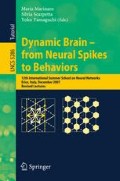Abstract
It is well accepted that medium to long range navigation requires the use of an external directional reference i.e. a compass. Cheung et al (2007) recently demonstrated through theory and simulation the quantitative significance of the compass. It was shown that navigating agents using and not using a compass could be differentiated on the basis of the population behaviour. In the current work, theory and simulation results will be presented on ways to characterize individual paths on the basis of whether the system was using an external directional reference. Thus it is demonstrated that important information concerning the neural input used by a navigating animal may be inferred probabilistically from its behaviour.
Access this chapter
Tax calculation will be finalised at checkout
Purchases are for personal use only
Preview
Unable to display preview. Download preview PDF.
References
Bovet, P., Benhamou, S.: Spatial analysis of animals’ movements using a correlated random walk model. J. Theor. Biol. 131, 419–433 (1988)
Cheung, A., Zhang, S., Stricker, C., Srinivasan, M.V.: Animal navigation: the difficulty of moving in a straight line. Biol. Cybern. 97, 47–61 (2007)
Pearson, K.: The problem of the random walk. Nature 72, 294 (1905)
Author information
Authors and Affiliations
Editor information
Editors and Affiliations
Rights and permissions
Copyright information
© 2008 Springer-Verlag Berlin Heidelberg
About this chapter
Cite this chapter
Cheung, A. (2008). From Behaviour to Brain Dynamics. In: Marinaro, M., Scarpetta, S., Yamaguchi, Y. (eds) Dynamic Brain - from Neural Spikes to Behaviors. NN 2007. Lecture Notes in Computer Science, vol 5286. Springer, Berlin, Heidelberg. https://doi.org/10.1007/978-3-540-88853-6_7
Download citation
DOI: https://doi.org/10.1007/978-3-540-88853-6_7
Publisher Name: Springer, Berlin, Heidelberg
Print ISBN: 978-3-540-88852-9
Online ISBN: 978-3-540-88853-6
eBook Packages: Computer ScienceComputer Science (R0)

